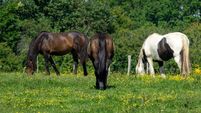Teagasc research can benefit infant formula producers, says expert
Dr Paul Ross, head of the Teagasc food research programme, says studies into human microbiota have the potential to transform much of the thinking on basic human nutrition, gut health and disease prevention.
Prof Paul O’Toole is leading a team of UCC/ Teagasc scientists on one project, called Eldermet, looking at faecal microbiota from elderly people. A second study, called Infantmet, led by Prof Catherine Stanton at Teagasc Moorepark, studies how breast feeding creates gut microbiota in early life.










